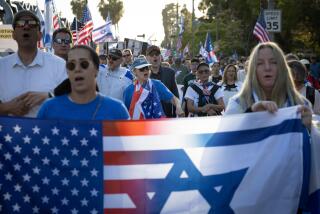War teaches kids lessons in tolerance
- Share via
The boy from Russia and the boy from Afghanistan recently faced off in the school hallway, a past war bringing them to the brink of a fight.
But after several class discussions about the battles now unfolding overseas, Elizar Benayvskiy and Abdul Haseeb Mirzakhail are no longer adversaries.
“I don’t care about where he is from. He is my friend,” said Elizar, 11.
“When you come to America, you’re like brothers,” said Abdul, 12.
In their school, Boone Elementary, and others across Chicago, teachers are seizing opportunities to instruct children about the U.S. war on terrorism, the complexities of the Arab world and the Muslim faith.
The challenging task often means playing counselor as well as instructor. But the resulting lessons can be powerful.
In an African-American neighborhood on the South Side, for example, pupils who had openly vowed revenge on Arab Muslims learned first-hand about the dangers of jumping to conclusions after their teacher revealed that she is among that group.
And Arab and Muslim pupils, often stung by schoolyard taunts of “terrorist,” have learned a new level of persuasive speech in informing peers that Osama bin Laden and Taliban leaders might share their ethnic and religious background, but they are fundamentally different people.
Such lessons are not easy for young minds.
“At the beginning, it was hard for everybody,” said Jenny Soro, an Assyrian raised in Iraq who teaches English to Boone’s immigrant pupils. “But now they are more open, and they are more comfortable. Imagine if we didn’t discuss this. Imagine how they would look at [Abdul] Haseeb from Afghanistan.”
In her classroom, Soro has a slogan of sorts: “We are one family. Each one represents one flower. Everyone is beautiful.”
The instruction has helped, Abdul said. The other kids now have a better understanding of him and his native country. The showdowns between him and two Russian immigrant boys have stopped.
His peers listened closely as he recently told the class that the World Trade Center should be rebuilt, but to a shorter height because he feared another plane attack.
“I don’t want the terrorists to do this to other people,” he said in unsteady English.
Having arrived in the United States six months ago, Abdul is still uneasy talking about Afghanistan. But he detests the Taliban: They abducted his father, a teacher, from the family home one evening when Abdul was about 6. He hasn’t seen or heard from his father since. He, his mother and his siblings later fled to Pakistan.
The war has sometimes been a strain at Boone, a Rogers Park school where the student body represents 36 languages. Administrators said a Bosnian girl recently complained to her mother that no one wanted to play with her anymore because she wears the Muslim head scarf.
That’s where classroom discussions can ease tension, educators said. It’s also where religion is inevitably broached, despite fears about separation of church and state in the public schools.
“If we didn’t discuss it in class, I think kids would get the wrong impression of [the Islamic] religion,” said 8th-grader Safi Khan, 13, a Muslim born in India. “We tell them that suicide is against our religion, and killing people is against our religion too.”
Limits to discussion
Khuram Paracha, 13, a Muslim whose parents are from Pakistan, said the classroom has been the only forum for him to share his anguish.
“You sort of keep all of this bottled up inside,” he said. “The first weeks, I didn’t say anything about [my background]. It was hard talking about it. It’s just embarrassing: You’re Muslim and Muslims did it. It made me sick to know Muslims did it. I felt like throwing up.”
There are limits to acceptable discussion. Boone Principal Karen Carlson said she thought a national weekly scholastic newsmagazine, used in many Chicago public schools, showed poor judgment in publishing photos of the attack, especially one of a bloody woman.
“It’s hard to stomach,” said Carlson.
For instructors of Arab Muslim background, the teaching experience has often been especially profound this fall.
Miriam Zayed, a teacher for 31 years at Earle Elementary School in the South Side’s Englewood neighborhood, recently asked her 5th graders how they felt about Arab Muslims.
“Tie them up,” “beat them,” “kill them,” the pupils responded.
She then disclosed that she was Palestinian and a Muslim. Her pupils were shocked. But they learned an important lesson, they said.
“When she told me she was Arab and Muslim, I felt bad about myself,” said Jerry Sims, 11, who had said he wanted to “choke” Arab Muslims after the attacks. “I would never hurt a teacher in my life.”
Jerry said he learned to “never say anything to hurt people or involve hurting people who are innocent.”
Wearing the hijab
Zayed’s sister, Hanan Zayid, also is a teacher, at Rosenwald Elementary School on the South Side, but Zayid, 45, wears the Muslim hijab, or head scarf. That has served as a prompt for discussions about Islam with pupils and teachers alike.
She and other Muslim teachers say they are vigilant about how much Islam they teach in the classroom.
“I don’t teach religion in school,” Zayid said. “What I do is compare the religions because it’s part of our social studies and ... history.”
Boone’s Soro said leading such discussions is an important part of a teacher’s job.
“It’s not just to teach how to read,” she said. “It’s how to build a human being, a responsible person.”
More to Read
Sign up for Essential California
The most important California stories and recommendations in your inbox every morning.
You may occasionally receive promotional content from the Los Angeles Times.












